Image: Detail from the Monument for Peace and Unity, Davao City, Mindanao, Philippines.
Why, despite the best of intentions and the investment of significant resources, do peace processes so often fail to lead to a stable and lasting peace after civil war?
‘Neither war nor peace’ is an all too familiar scenario in many post-war contexts, and it looks as if Syria may be about to join countries such as Liberia, East Timor and Iraq in this unenviable state of limbo. If Syria’s peace talks do lead to an agreement, a major peacebuilding operation will follow. So how does the international community make sure that any attempt to build peace does not inadvertently lead merely to the absence of all-out war? Are there any examples of ‘positive deviance’ that can point the way?
A big part of the challenge is that the dominant international approaches to peace processes and peacebuilding focus primarily on technical fixes that ignore the unique political contexts of post-conflict societies. They fail to acknowledge the deeply embedded power dynamics that often play key roles in sparking and perpetuating conflict.
Essentially, peace itself is depoliticised by these peace processes: civil conflict is understood primarily as the result of a dysfunctional state, and peace is pursued through a set of mechanisms that attempt to “fix” the state to return order and security to its population.
Even where there is not a full-scale resumption of war, individuals and communities continue to be beset by violence, insecurity, instability and mistrust in many post-conflict societies. For the last six years I have investigated this puzzle, drawing on case studies from across Africa, Asia and the Pacific, and it seems there are two key challenges facing peace consolidation.
First, practical challenges undermine the consolidation of peace in many post-conflict states. These range from the delayed deployment of peacekeepers to poorly designed programs for disarmament, demobilisation and reintegration (DDR) and security sector reform (SSR); from insufficient funds and resources for peacebuilding activities to the bad faith or lack of commitment to peace among those who are supposedly engaging with the process. The good news is that practical challenges have practical solutions, and the international community seems to be getting better at finding them.
However, my research suggests a second and more intractable challenge: many peace processes are undermined because they do not ask what factors motivate individuals or groups to use violence – or to buy into the peace. If no effort is made to understand these dynamics, there can be no response. This is a systemic problem, a symptom of the deeply technocratic and bureaucratic way the international community engages in peace processes.
This approach makes a set of assumptions about what a post-conflict state and society should look like and how it gets there, regardless of context. Peace is taken to be a fundamentally uncontested idea. Yet the realities of peacebuilding illustrated by a wide range of highly contested peace processes suggest exactly the opposite.
Civil wars are deeply political affairs. They are about how a society’s power and authority are embodied and exercised. Divorcing a peace process from this produces a hollow peace: the institutions and structures of security, governance, and transitional justice become disconnected from the dynamics of politics and social organisation. It is hard to see how those new institutions can consolidate peace if this is so. It is more likely that the ‘peace’ will be captured and manipulated by elite interests, helping to perpetuate the insecurity and instability that the end of conflict was supposed to resolve.
Yet there are examples of peace processes, or elements of peace processes, that deviate from the dominant model and which have more effectively responded to the dynamics of conflict-affected communities. For example, an innovative approach to DDR in Mindanao in the Philippines in the mid-1990s recognised that the deeply embedded gun culture and a volatile security situation would make it impossible to disarm and demobilise the Mindanao National Liberation Front – and so DDR was done without the ‘D’s.
In Nepal, after the 10-year Maoist insurgency, the usual typical ‘heavy footprint’ peacekeeping operation was discarded – after some resistance from the UN establishment – in favour of a ‘light footprint designer mission’ with a very small contingent of unarmed military officers. This made international intervention acceptable to both the local parties and regional actors, and meant that the process remained locally owned and driven.
Both cases show that alternatives to the dominant approach can be highly effective and avoid the pitfalls of template-based peacebuilding. It is worth noting, however, that responsiveness to local context can’t simply be added to the existing model. Peace processes need to be bespoke and flexible. They need to:
- tailor the form of each process to suit the specific functions of the process, the context in which it operates, and the needs of the local population;
- regularly assess the interaction of these factors and the constituent elements of the peace process so that shifts can be made in response to changing conditions, outcomes, and challenges.
I’m not suggesting we start over in each post-war context with deep musings on the nature of peace and conflict. But the evidence clearly suggests that the options in the peacebuilding toolbox would work better if they were selected after a genuine consideration and discussion of their utility, and of their likely impact in each individual context.









